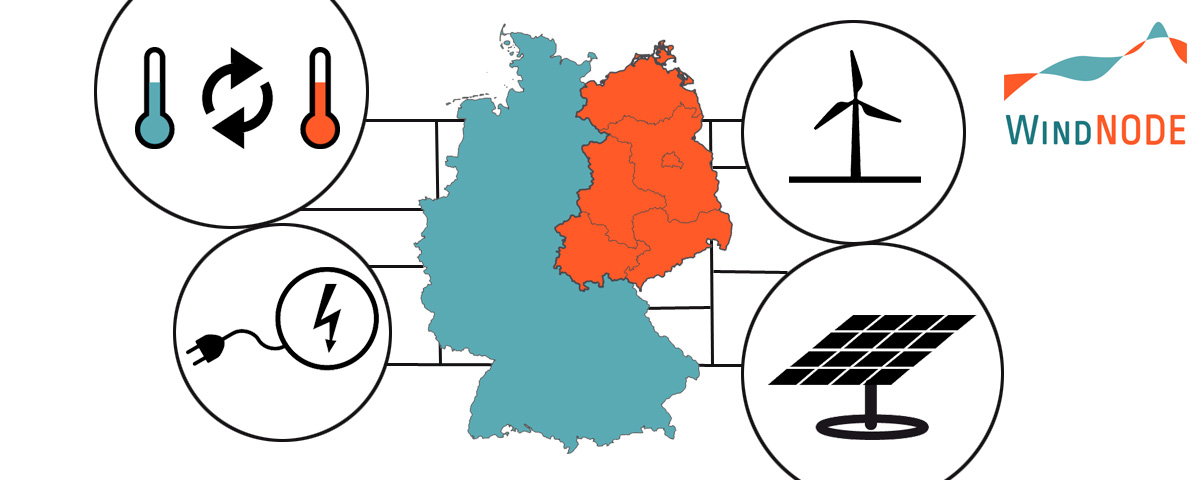
WindNODE Consortium Congretagion
14. March 2018
Berkeley-Berlin Energy Access Group
27. March 2018The eGo grid model: An open-source and open-data based synthetic medium-voltage grid model for distribution power supply systems (Amme et al. 2017)

Jonathan Amme, Guido Pleßmann, Jochen Bühler, Ludwig Hülk, Editha Kötter, Peter Schwaegerl
This paper has been submitted to the SciGRID International Conference on Power Grid Modelling and has been published in IOP Conf. Series: Journal of Physics: Conf. Series. 977 (2018)
Abstract — The increasing integration of renewable energy into the electricity supply system creates new challenges for distribution grids. The planning and operation of distribution systems requires appropriate grid models that consider the heterogeneity of existing grids.
In this paper, we describe a novel method to generate synthetic medium-voltage (MV) grids, which we applied in our DIstribution Network GeneratOr (DINGO). DINGO is open-source software and uses freely available data.
Medium-voltage grid topologies are synthesized based on location and electricity demand in defined demand areas. For this purpose, we use GIS data containing demand areas with high-resolution spatial data on physical properties, land use, energy, and demography. The grid topology is treated as a capacitated vehicle routing problem (CVRP) combined with a \emph{local search} metaheuristics. We also consider the current planning principles for MV distribution networks, paying special attention to line congestion and voltage limit violations. In the modelling process, we included power flow calculations for validation.
The resulting grid model datasets contain 3608 synthetic MV grids in high resolution, covering all of Germany and taking local characteristics into account. We compared the modelled networks with real network data. In terms of number of transformers and total cable length, we conclude that the method presented in this paper generates realistic grids that could be used to implement a cost-optimised electrical energy system.
The increasing integration of renewable energy into the electricity supply system creates new challenges for distribution grids. The planning and operation of distribution systems requires appropriate grid models that consider the heterogeneity of existing grids.
In this paper, we describe a novel method to generate synthetic medium-voltage (MV) grids, which we applied in our DIstribution Network GeneratOr (DINGO). DINGO is open-source software and uses freely available data.
Medium-voltage grid topologies are synthesized based on location and electricity demand in defined demand areas. For this purpose, we use GIS data containing demand areas with high-resolution spatial data on physical properties, land use, energy, and demography. The grid topology is treated as a capacitated vehicle routing problem (CVRP) combined with a local search metaheuristics. We also consider the current planning principles for MV distribution networks, paying special attention to line congestion and voltage limit violations. In the modelling process, we included power flow calculations for validation.
The resulting grid model datasets contain 3608 synthetic MV grids in high resolution, covering all of Germany and taking local characteristics into account. We compared the modelled networks with real network data. In terms of number of transformers and total cable length, we conclude that the method presented in this paper generates realistic grids that could be used to implement a cost-optimised electrical energy system.
The increasing integration of renewable energy into the electricity supply system creates new challenges for distribution grids. The planning and operation of distribution systems requires appropriate grid models that consider the heterogeneity of existing grids.
In this paper, we describe a novel method to generate synthetic medium-voltage (MV) grids, which we applied in our DIstribution Network GeneratOr (DINGO). DINGO is open-source software and uses freely available data.
Medium-voltage grid topologies are synthesized based on location and electricity demand in defined demand areas. For this purpose, we use GIS data containing demand areas with high-resolution spatial data on physical properties, land use, energy, and demography. The grid topology is treated as a capacitated vehicle routing problem (CVRP) combined with a local search metaheuristics. We also consider the current planning principles for MV distribution networks, paying special attention to line congestion and voltage limit violations. In the modelling process, we included power flow calculations for validation.
The resulting grid model datasets contain 3608 synthetic MV grids in high resolution, covering all of Germany and taking local characteristics into account. We compared the modelled networks with real network data. In terms of number of transformers and total cable length, we conclude that the method presented in this paper generates realistic grids that could be used to implement a cost-optimised electrical energy system.




